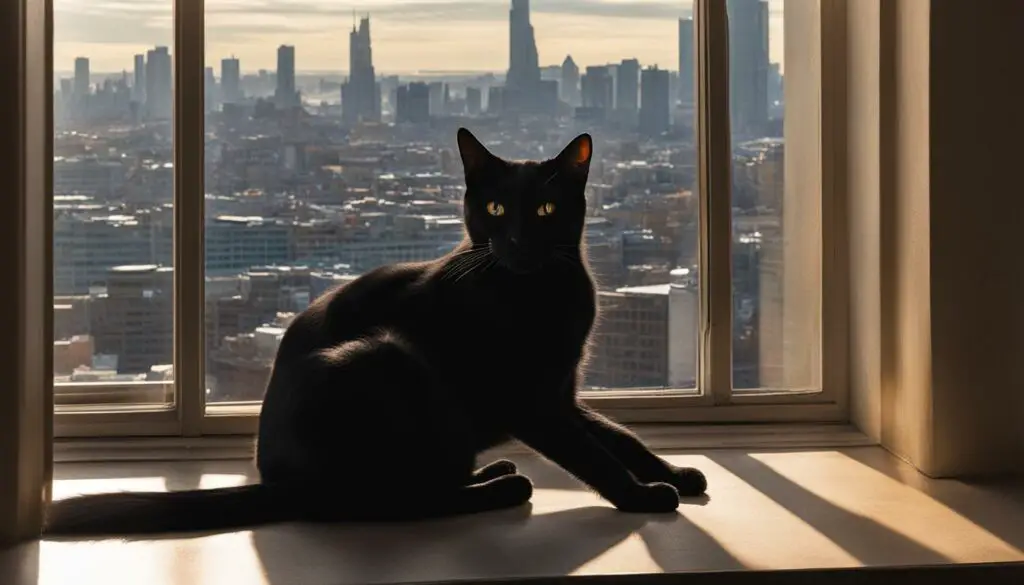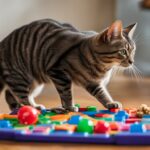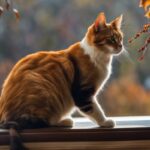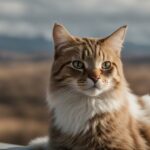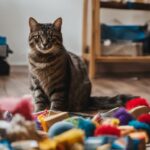When it comes to our feline friends, one question that often arises is: are cats truly independent creatures? As a cat lover myself, I’ve always been fascinated by their mysterious nature and ability to navigate the world with such grace and self-assurance. In this article, we’ll delve into the enigma of cat behavior and explore the unique characteristics that contribute to their reputation as independent creatures.
Key Takeaways:
- Cats have a reputation for being independent creatures
- Their solitary nature allows them to be self-reliant and comfortable spending time alone
- Genetics play a significant role in the independence of cats
- Mental stimulation and training can enhance their independence
- Understanding their communication signals is important for building a bond with independent cats
The Enigma of Feline Behavior
Cats are fascinating creatures with a behavior that often baffles and mystifies us. Their independent nature is one of their most intriguing traits. Understanding their behavior and personality can shed light on the enigma of feline independence.
One of the key characteristics of independent cats is their preference for solitude. Unlike many other animals, cats enjoy spending time alone and having their own space. This solitary behavior allows them to be self-reliant and independent, as they can take care of themselves without relying on constant social interactions.
Independent cats also have distinct personality traits that contribute to their independence. They tend to be more aloof and less reliant on human companionship compared to other cats. They may enjoy having their own designated area in the house where they can retreat to and feel safe.
| Characteristics of Independent Cats | Examples |
|---|---|
| Prefer their own space | Having a specific hiding spot or designated area |
| Less reliant on human attention | Not constantly seeking affection or interaction |
| Self-sufficient | Able to entertain themselves with toys and activities |
In conclusion, the behavior and personality of independent cats are what make them fascinating and mysterious creatures. Their preference for solitude, distinct personality traits, and self-sufficiency contribute to their reputation as independent beings. Understanding and respecting their individual needs and boundaries is crucial in building a harmonious relationship with these enigmatic feline companions.
The Nature of Solitary Animals
Cats are inherently solitary animals, meaning they are comfortable being alone and don’t rely on social interactions for their well-being. This self-reliance and independence are ingrained in their instincts and behavior. Unlike pack animals such as dogs, cats have adapted to survive and thrive on their own.
Being solitary allows cats to have a sense of control over their surroundings. They can explore their environment freely, hunt for food, and find shelter without the need for companionship. Cats are natural predators, and their independent nature enables them to be efficient hunters, relying on their sharp senses and agility to capture prey.
One of the fascinating aspects of cats as solitary animals is their ability to entertain themselves. They have a wide range of behaviors and activities that keep them occupied and mentally stimulated. From playing with toys to engaging in self-grooming rituals, cats have developed ways to keep themselves entertained and content.
Benefits of Self-Reliance
The self-reliant nature of cats has several benefits. For one, it allows them to adapt and thrive in various environments. Whether living in a house or as outdoor cats, their independence enables them to navigate and survive in different settings. Additionally, their self-sufficiency means that cats require less maintenance compared to more dependent pets.
| Benefits of Cat Independence | Explanation |
|---|---|
| Lower need for constant attention | Cats can entertain themselves and don’t require constant interaction from humans. |
| Less reliance on human companionship | Cats are content being alone and don’t require constant social interaction. |
| Natural hunting skills | Their independent nature allows them to use their hunting instincts efficiently. |
| Ability to self-groom | Cats are meticulous groomers, keeping themselves clean and healthy. |
Understanding and appreciating the solitary nature of cats is crucial for providing them with the appropriate environment and care. While they may not seek constant attention or affection, cats still require love, care, and mental stimulation from their human companions. By acknowledging and respecting their independence, we can establish a strong and harmonious bond with our feline friends.
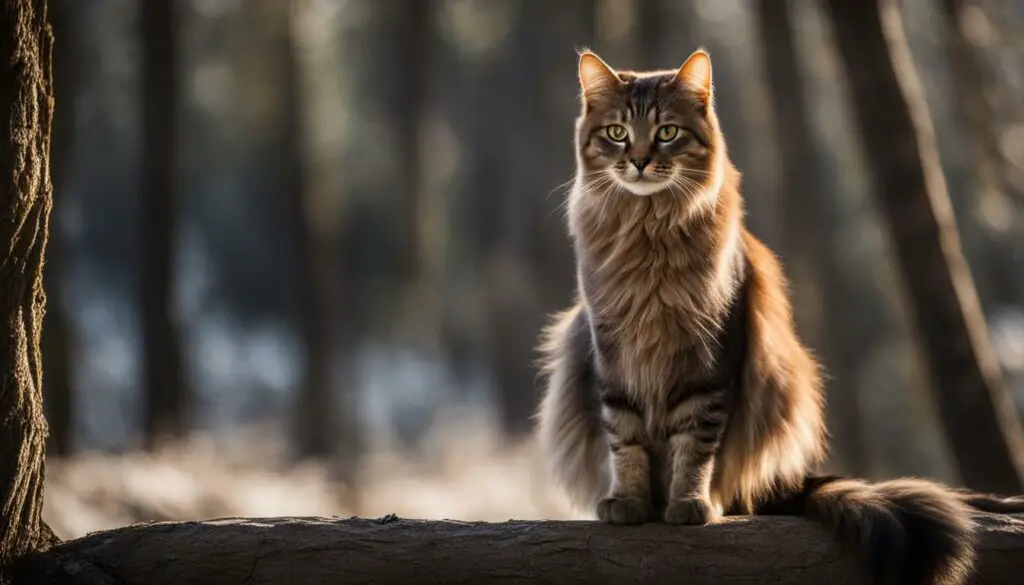
The Independent Cat Personality
When it comes to cat behavior, one of the most fascinating aspects is the independent nature that many cats possess. Cats with an independent personality tend to exhibit certain traits that set them apart from their more dependent counterparts. These cats prefer to have their own space and are less likely to seek constant attention or affection from their owners.
Independent cats often display a sense of aloofness, keeping their own company and finding contentment in solitude. They are selective about the social interactions they engage in and may not rely heavily on human companionship. This can be attributed to their innate self-reliance and their ability to entertain themselves.
In addition to being more self-sufficient, independent cats also have a higher tendency to establish clear boundaries. They may have a designated area in the house where they retreat to for relaxation and solitude. This space provides them with a sense of security and independence, allowing them to feel in control of their environment.
The Unique Characteristics of Independent Cats
Table: Characteristics of Independent Cats
| Characteristics | Description |
|---|---|
| Preference for personal space | Independent cats often enjoy having their own designated area in the house where they can retreat to and feel safe. |
| Self-sufficiency | These cats are more self-reliant and can entertain themselves with toys and activities. |
| Clear boundaries | Independent cats establish clear boundaries and may be more selective in their social interactions. |
Independent cats often have distinct personality traits that contribute to their independence. They tend to be more aloof and less reliant on human companionship.
Understanding and respecting the independent nature of these cats is crucial for fostering a harmonious relationship. Providing them with a safe and enriching environment, along with opportunities for mental stimulation, can help support their independence and overall well-being.
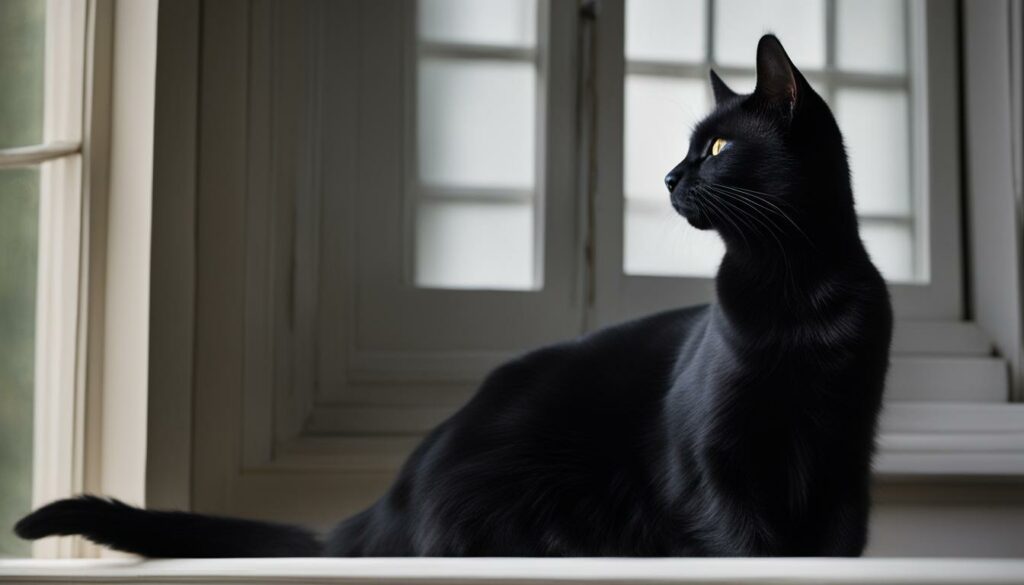
The Unique Characteristics of Independent Cats
Cats that exhibit independent behavior have certain characteristics that set them apart from their more sociable counterparts. These cats often prefer to have their own space and may be considered aloof by some. Here are some key characteristics of independent cats:
Solitary Nature:
Independent cats are comfortable being alone and enjoy their own company. They have a natural inclination towards solitude and are less reliant on social interactions for their well-being. They prefer to have their own designated area in the house where they can retreat to and feel safe.
Preference for Personal Space:
Cats that like their own space often have a strong need for personal territory. They desire a defined area where they can relax undisturbed. This space may include cozy hiding spots, secluded corners, or elevated perches that offer a sense of security and control over their environment.
Aloof Demeanor:
Independent cats can sometimes exhibit an aloof demeanor. They may appear more self-reliant and less inclined to seek constant attention or affection from their owners. While they may enjoy occasional interactions, they typically prefer to maintain a level of distance and independence.
Understanding and respecting these unique characteristics of independent cats is essential for establishing a harmonious relationship with them. Providing them with their own space and allowing them to set boundaries can help foster their sense of independence and overall well-being.
| Characteristics of Independent Cats | Description |
|---|---|
| Solitary Nature | Cats are comfortable being alone and do not rely heavily on social interactions. |
| Preference for Personal Space | Independent cats require their own designated area where they can relax undisturbed. |
| Aloof Demeanor | Independent cats may appear more self-reliant and may not seek constant attention or affection. |
The Genetic Influences on Cat Independence
When it comes to understanding the independent nature of cats, genetics plays a significant role. Different cat breeds may have a higher inclination towards independence due to their genetic makeup. The breeding process and the selection of specific traits also contribute to the independence of individual cats.
Researchers have identified specific genetic factors that influence a cat’s independence. These factors can determine their predisposition towards self-reliance and their ability to thrive in a solitary environment. Understanding the genetic influences on cat independence can provide valuable insights into their behavior and help us better meet their needs.
To illustrate the genetic influences on independence, let’s take a look at a comparison table:
| Breed | Independence Level | Genetic Factors |
|---|---|---|
| Maine Coon | Medium | Genetic variation in dopamine receptors |
| Siamese | Low | Elevated oxytocin and serotonin levels |
| Persian | High | Genetic mutation in brain connectivity |
As seen in the table, different breeds have varying degrees of independence. The Maine Coon, known for its medium independence level, has genetic variations in dopamine receptors that contribute to its self-assured nature. On the other hand, the Siamese, with low independence levels, has elevated oxytocin and serotonin levels that make them more sociable and reliant on human companionship. The Persian breed, with its high independence level, has a genetic mutation in brain connectivity that enhances its ability to navigate the world independently.
The Role of Mental Stimulation in Fostering Independent Cat Behavior
Providing mental stimulation is a crucial factor in nurturing the independent behavior of cats. Just like humans, cats need mental exercise to keep their minds sharp and engaged. Engaging in activities that challenge their problem-solving abilities and tap into their natural instincts can lead to a more confident and self-reliant feline companion.
Mental stimulation can take various forms, such as interactive playtime sessions, puzzle toys, and environmental enrichment. Engaging in play with your cat not only provides physical exercise but also provides an opportunity for them to use their problem-solving skills. Interactive toys that require cats to figure out how to retrieve treats or toys can provide a stimulating challenge and encourage independent behavior.
“Mental stimulation plays a significant role in fostering independent behavior in cats. It keeps their minds active, satisfies their natural curiosity, and allows them to explore and engage in behaviors that come naturally to them.”
Creating an environment that offers opportunities for exploration and problem-solving can also contribute to their independence. Providing scratching posts, perches, and hiding spots can give cats a sense of control and independence over their surroundings. These elements allow them to engage in natural behaviors such as climbing, scratching, and observing their surroundings from a secure vantage point.
Nurturing Independence Through Mental Stimulation
Mental stimulation allows cats to exercise their natural instincts and maintain a healthy level of independence. It also helps prevent boredom, which can lead to behavioral issues such as excessive meowing or destructive behavior. By incorporating mental stimulation into their daily routine, cat owners can foster a sense of independence and overall well-being for their feline companions.
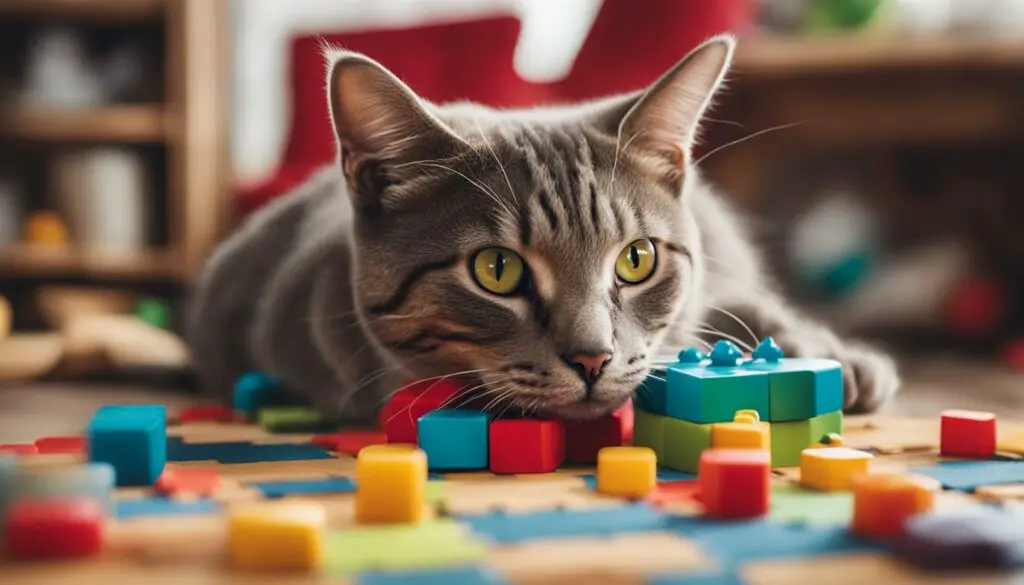
| Mental Stimulation Activities | Benefits |
|---|---|
| Interactive Playtime | Improves problem-solving skills and encourages independent behavior |
| Puzzle Toys | Stimulates the mind and provides a challenge that promotes independent problem-solving |
| Environmental Enrichment | Offers opportunities for exploration, creates a sense of control, and satisfies natural instincts |
By incorporating mental stimulation activities into your cat’s daily routine, you can help promote their independence, keep their minds sharp, and provide them with a fulfilling and enriched life. Remember to tailor the activities to your cat’s individual preferences and abilities, ensuring a positive and enjoyable experience for both you and your feline companion.
Training and Independence
Teaching independence to cats requires a patient and understanding approach. While cats may not be as easily trainable as dogs, it is possible to shape their behavior and encourage independent tendencies. Positive reinforcement methods can be utilized to reward desired behaviors and discourage unwanted ones. By using treats, praise, and play as rewards, cats can learn to associate independent behavior with positive outcomes.
One important aspect of training independent cats is establishing clear boundaries. This can be done by providing them with their own designated spaces within the home, such as a scratching post, a cozy bed, or a cat tree. Creating an environment that accommodates their need for privacy and independence can help them feel secure and confident.
Cats can also be taught to engage in independent activities by providing them with interactive toys and puzzle feeders. These toys can stimulate their natural hunting instincts and encourage them to seek mental and physical stimulation on their own. Additionally, teaching cats to use a litter box and a scratching post can further promote their independence, as they will have the tools necessary to meet their basic needs.
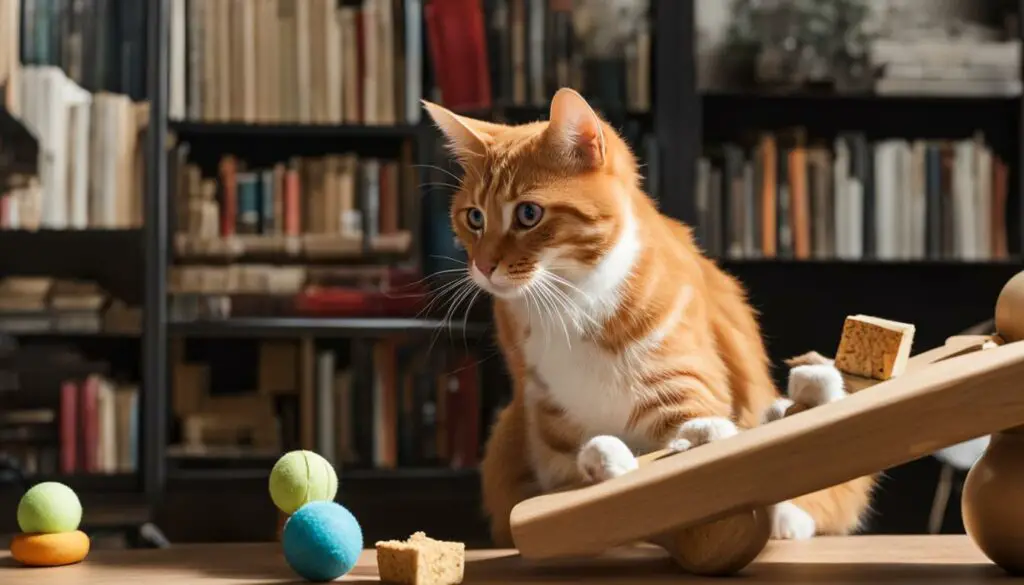
In conclusion, while cats are known for their independent nature, they can still be trained to exhibit behaviors that enhance their independence. By utilizing positive reinforcement, establishing boundaries, and providing mental and physical stimulation, cat owners can foster a sense of self-reliance and promote a harmonious relationship with their feline companions.
The Social Nature of Cats
While cats are often associated with independence, they are also social creatures that enjoy human companionship. Despite their independent behavior, cats have a unique way of forming strong bonds with their owners and other animals. Understanding their social interactions can help foster a deeper connection and ensure their emotional well-being.
Cats exhibit social behaviors that are different from more dependent animals. They may not seek constant attention or affection, but they still enjoy companionship in their own unique way. Cats often show their affection through subtle cues, such as rubbing against their owners or purring softly. This demonstrates their desire for closeness and connection, while still maintaining their independence.
Creating a positive social environment for cats is essential for their overall happiness. Providing opportunities for interaction, such as playtime and gentle grooming sessions, can strengthen the bond between cats and their owners. Additionally, allowing cats to socialize with other compatible feline companions can fulfill their need for social stimulation.
Understanding Cat Companionship
It’s important to recognize that each cat is an individual with unique social preferences. Some cats may thrive in a multi-cat household, enjoying the companionship of other feline friends. Others may prefer a quieter environment with fewer social interactions. Respect their boundaries and provide them with the social experiences that align with their personality and preferences.
| Social Behaviors | Description |
|---|---|
| Allogrooming | Cats groom each other as a sign of social bonding and affection. |
| Play Behavior | Cats engage in play to establish social hierarchies and practice hunting skills. |
| Body Language | Cats use their body posture, tail movements, and ear positions to communicate their social intentions. |
| Vocalizations | Cats may meow, purr, and make other sounds to express their social needs and emotions. |
| Scent Marking | Cats use pheromones to mark their territory and communicate with other cats. |
Understanding and respecting the social nature of cats is crucial for building a strong and harmonious relationship with our feline companions. By providing them with the appropriate social interactions and creating a positive environment, we can ensure their well-being and happiness.
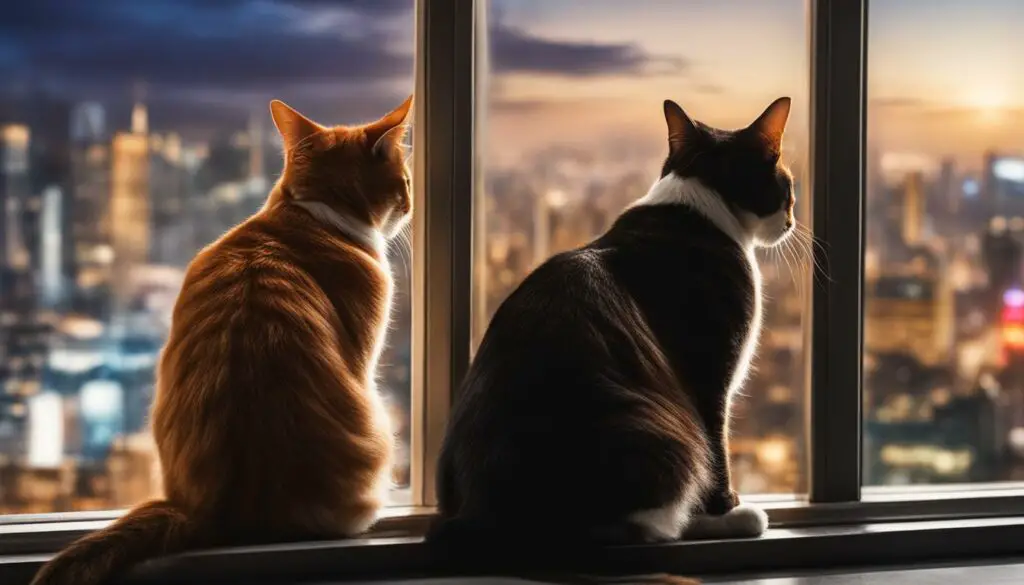
Communication and Independence
In order to truly understand and connect with independent cats, it is important to recognize and interpret their unique communication signals. Cats rely on a combination of verbal and non-verbal cues to express their needs, desires, and emotions. By paying attention to their body language, vocalizations, and facial expressions, we can establish a deeper understanding of their independent nature.
When it comes to body language, independent cats often display certain behaviors that indicate their desire for space and autonomy. They may hold their tail upright and slightly curved, signifying confidence and independence. Dilated pupils can indicate excitement or curiosity, while narrowed eyes may suggest wariness or a desire for solitude. Understanding these subtle cues allows us to respect their boundaries and provide them with the independence they crave.
“Cats have a sophisticated system of communication, both through vocalizations and body language. By observing their behavior and responding appropriately, we can strengthen our bond with them while still honoring their need for independence.”
Vocalizations also play a crucial role in cat communication. Independent cats may use a variety of sounds to express themselves, from the familiar meow to trills, chirps, and purrs. Each vocalization carries its own meaning, whether it’s a request for attention, a greeting, or a warning. Paying attention to these sounds and responding accordingly can help foster a deeper connection with independent cats.
Understanding Independent Cat Communication
To summarize, independent cats have their own unique way of communicating their desires and needs. By observing and interpreting their body language, vocalizations, and facial expressions, we can gain insight into their independent nature and build a stronger bond with them. Remember to give them the space and autonomy they crave, while still providing them with the love, care, and mental stimulation they need to thrive.
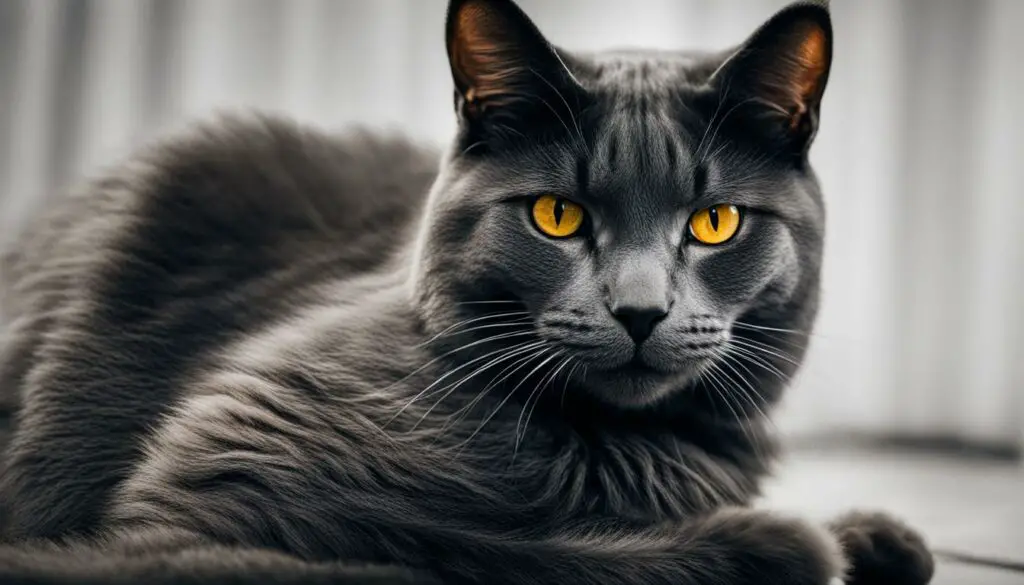
Table: Common Cat Communication Signals
| Communication Signal | Meaning |
|---|---|
| Upright, slightly curved tail | Confidence and independence |
| Dilated pupils | Excitement or curiosity |
| Narrowed eyes | Wariness or desire for solitude |
| Meow | Request for attention or greeting |
| Trills, chirps, and purrs | Expression of contentment or communication |
Environmental Enrichment for Independent Cats
Cats are highly independent creatures, but providing them with a stimulating environment is crucial for their overall well-being. Environmental enrichment refers to the practice of creating a living space that meets a cat’s instinctual needs and provides mental and physical stimulation. By setting up their environment in a way that encourages natural behaviors, we can enhance their independence and happiness.
One way to enrich a cat’s environment is by offering a variety of toys that cater to their natural instincts. Toys that mimic prey, such as feather wands or interactive puzzle toys, can engage their hunting skills and keep them mentally stimulated. Providing different types of toys and regularly rotating them can prevent boredom and encourage independent play.
Creating vertical spaces is another important aspect of environmental enrichment. Cats love to climb and perch on high surfaces, so providing them with vertical options such as cat trees, shelves, or window perches allows them to explore their surroundings and feel safe. These spaces can also give them a sense of ownership and independence within their territory.
| Benefits of Environmental Enrichment for Cats | Examples |
|---|---|
| Prevents boredom and destructive behavior |
|
| Promotes exercise and physical health |
|
| Reduces stress and anxiety |
|
Providing an enriching environment for your independent cat not only enhances their quality of life but also strengthens the bond between you and your feline companion.
Creating a Safe Outdoor Environment
If your cat has access to the outdoors, it’s important to ensure their safety while still allowing them to explore and exercise their independence. Consider creating a secure outdoor enclosure or installing a cat-proof fence to prevent them from wandering off or encountering potential dangers like traffic or predators. Outdoor enclosures can be equipped with scratching posts, perches, and even plants for a more natural experience.
Remember, every cat is unique, and their environmental enrichment needs may vary. Observing their behavior and preferences will help you tailor their environment to suit their individual needs. By providing a stimulating and enriching environment, you’ll be supporting your cat’s independence and overall well-being.
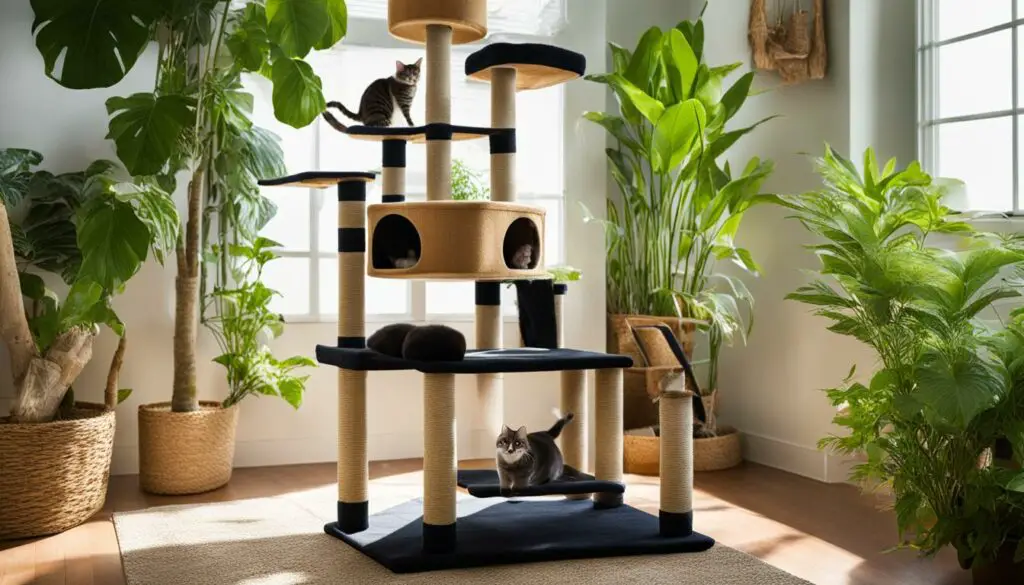
The Intelligence of Independent Cats
When it comes to intelligence, independent cats possess their own unique cognitive abilities. While they may not excel in problem-solving tasks like some dog breeds, they have other mental capabilities that contribute to their independence. Cats have impressive memory and recall capabilities, allowing them to adapt to their environment and find solutions to everyday challenges.
One fascinating aspect of cat intelligence is their ability to navigate their territory. Cats have a remarkable sense of spatial awareness and can create mental maps of their surroundings. This enables them to navigate even complex environments with ease, demonstrating their astute cognitive abilities.
“Cats have an incredible knack for memorizing routes and remembering landmarks in their environment. They can effortlessly find their way back home, even after exploring unfamiliar territory,” says Dr. Jane Carter, a feline behavior expert.
| Intelligence Traits | Description |
|---|---|
| Adaptability | Cats have a remarkable ability to adapt to different situations and environments, showcasing their flexible intelligence. |
| Problem-Solving | Although cats may not excel in problem-solving tasks, they can use their intelligence to find creative solutions to challenges they encounter. |
| Curiosity | Their innate curiosity drives their desire to explore and learn, fostering their intellectual growth. |
| Observational Skills | Cats are highly observant creatures, carefully studying their surroundings and learning from their observations. |
While independent cats may not seek constant attention or engage in obedience tasks like some other pets, their intelligence shines through their adaptability, problem-solving abilities, curiosity, and observational skills. Understanding and appreciating their unique cognitive strengths is essential for providing them with the mental stimulation they need to thrive.
The Role of Genetics in Independent Cat Behavior
Genetics play a crucial role in shaping the behavior and independence of cats. Through selective breeding and the inheritance of specific genes, certain breeds have developed a higher inclination towards independence. This genetic predisposition can manifest in various ways, influencing a cat’s personality, social interactions, and overall behavior.
One genetic factor that contributes to cat independence is their level of sociability. Some cats inherit genes that make them more prone to seeking human companionship and forming strong bonds, while others have a genetic makeup that favors a more independent and self-reliant nature. These genetic differences can result in varying levels of affection and interaction with their owners.
In addition to sociability, genetics also influence a cat’s temperament and personality traits. Independent cats often exhibit characteristics such as aloofness and self-sufficiency. These traits are thought to be influenced by specific genes that regulate a cat’s behavior and cognitive abilities. While more research is needed to fully understand the genetic basis of these traits, it is clear that genetics play a significant role in shaping a cat’s independence.
| Genetic Factors in Cat Independence | Description |
|---|---|
| Genes related to sociability | Some cats have genes that make them more sociable and dependent on human companionship, while others have genes that promote independence. |
| Temperament genes | Specific genes influence a cat’s temperament, with independent cats often displaying traits such as aloofness and self-sufficiency. |
| Cognitive genes | Genetic factors can also influence a cat’s cognitive abilities, which contribute to their adaptability and problem-solving skills in navigating their environment. |
Understanding the role of genetics in cat behavior helps us appreciate the unique qualities of independent cats. By recognizing their genetic predispositions, we can create an environment that supports their independence while still providing the necessary care and attention they need.
While genetics may play a significant role, it’s important to note that environmental factors and individual experiences also contribute to a cat’s behavior. A cat’s genetics may provide a foundation for independence, but their upbringing and interactions with their environment play a crucial role in shaping their behavior and level of independence.
Cat Spirit Animals and Independence
When it comes to cats, their independence is often admired and revered. But have you ever wondered if there is a deeper connection between cat behavior and something beyond our physical world? Many people believe that cats embody the spirit animal archetype of independence, curiosity, and mystery.
For centuries, cats have been associated with a sense of enigma and self-reliance. In various cultures and spiritual beliefs, the cat spirit animal symbolizes embracing one’s own independence and intuition. It encourages individuals to explore their unique traits and embrace their inner independence.
The cat spirit animal reminds us to trust our instincts, navigate our own paths, and embrace our individuality. It represents our innate ability to be self-sufficient and explore life’s mysteries with curiosity and grace.
Connecting with the cat spirit animal allows us to tap into our own inner strength, adaptability, and quick thinking. By observing and understanding cat behavior, we can learn lessons about independence, self-reliance, and the power of intuition.
So the next time you gaze into the eyes of your feline companion, remember the ancient connection between cats and independence. They serve as a reminder to honor and nurture our own independent spirits and to trust the wisdom that lies within us.
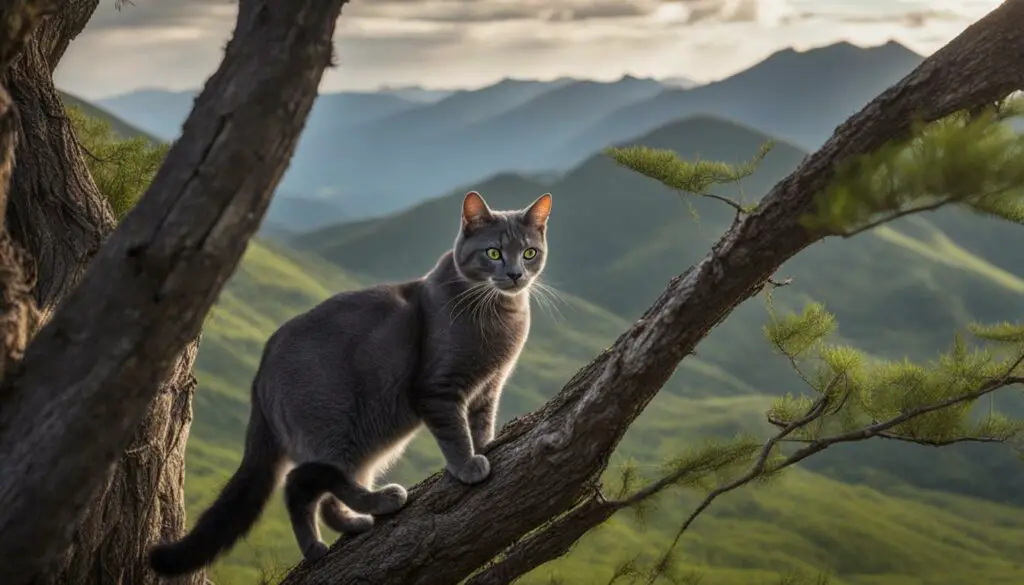
Debunking Misconceptions: The Case of the “Cat Girl”
As a journalist, it is important to separate fact from fiction and present accurate information to the public. In recent years, there has been a widely spread story of a girl who identifies as a cat. However, upon closer examination, it becomes clear that this story is based on false information. It is crucial to debunk this misconception and shed light on the truth.
This story gained traction quickly due to its sensational nature, capturing the attention of the media and the public. However, it is essential to critically evaluate news and not perpetuate false narratives. In this case, the story of the “Cat Girl” is a result of misinformation, highlighting the need for responsible reporting and fact-checking.
Misconceptions about cat identification can easily arise when sensationalized stories like this one circulate. It is important to remember that identifying as a cat is not a genuine phenomenon and should not be generalized to all cat behavior or human-cat relationships. Cats are independent creatures with their own unique characteristics, but they are not humans in feline form.
As journalists, it is our duty to present accurate information and debunk misconceptions. By critically evaluating and fact-checking stories, we can ensure that the public is informed and not misled by sensationalized narratives like the “Cat Girl” story. Let us embrace responsible reporting and promote a better understanding of cats and their true nature.

Table: Fact vs. Fiction
| Fact | Fiction |
|---|---|
| Cats are independent animals. | Cats are humans in feline form. |
| Identifying as a cat is not a genuine phenomenon. | Humans can transform into cats. |
| Responsible reporting is essential. | Sensationalized stories should be perpetuated. |
| Accurate information helps debunk misconceptions. | Misinformation should be spread. |
Conclusion: Understanding the Independence of Cats
After delving into the enigmatic world of cats, it’s clear that their independence is deeply ingrained in their nature. While some felines exhibit strong independent behavior, others may have a greater inclination towards social interactions. It’s important to recognize and respect the individual personality and needs of each cat to foster a harmonious relationship between humans and their feline companions.
Cats are solitary animals by nature, capable of entertaining themselves, finding food, and seeking shelter without relying on others. Their aloofness and preference for their own space contribute to their reputation as independent creatures. However, this doesn’t mean that they don’t enjoy companionship. Cats can form strong bonds with their owners and engage in social interactions, albeit in their unique, independent way.
Providing mental stimulation and an enriching environment for cats is essential to nurturing their independence. Engaging them in playtime, offering puzzle toys, and creating spaces for exploration allow them to satisfy their curiosity and keep their minds sharp. Additionally, positive reinforcement training can encourage independent behavior, setting boundaries while still honoring their need for independence.
While genetics play a significant role in determining a cat’s independence, it is important to remember that every cat is an individual. Their unique intelligence, communication styles, and distinct personality traits shape their level of independence. By understanding and embracing these characteristics, we can better appreciate and nurture the independence that makes cats such fascinating companions.
FAQ
Are all cats independent?
No, not all cats are independent. While independence is a common trait among cats, there are some cats that are more reliant on human companionship.
How do I know if my cat is independent?
Independent cats tend to exhibit behaviors such as preferring to spend time alone, seeking their own space, and being less reliant on constant attention or affection from their owners.
Can I train my cat to be more independent?
While cats are not as easily trainable as dogs, you can teach them certain behaviors that promote independence. Positive reinforcement methods can be used to encourage independent behaviors such as using litter boxes and scratching posts.
Do independent cats enjoy companionship?
While independent cats may not seek constant attention or affection, they can still form strong bonds with their owners and enjoy companionship. Their social interactions may differ from more dependent animals, but they can still appreciate the presence of others.
How can I communicate with my independent cat?
Cats communicate through both verbal and non-verbal cues. They use body language, vocalizations, and facial expressions to express their needs and emotions. Understanding their communication signals is important for building a bond with independent cats.
What can I do to promote my cat’s independence?
Providing an enriching environment with toys, scratching posts, and perches can help promote your cat’s independence. Creating spaces where they can explore and engage in natural behaviors enhances their independence and overall well-being.
Are independent cats less intelligent?
Independent cats have their own unique intelligence. While they may not excel in problem-solving tasks, they have other cognitive abilities such as memory and recall capabilities that contribute to their independence.
Can genetics influence a cat’s independence?
Yes, genetics play a significant role in the behavior and independence of cats. Certain breeds may have a higher inclination towards independence due to their genetic makeup, and individual cats may have a predisposition towards independence.
What is a cat spirit animal?
In spiritual beliefs, a cat spirit animal represents independence, curiosity, and mystery. It is seen as a symbol of embracing one’s own independence and intuition.
What was the story of the “Cat Girl” about?
The widely spread story of a girl identifying as a cat was based on false information. It serves as a reminder to critically evaluate news and avoid perpetuating misconceptions.
Can I bond with an independent cat?
Yes! While independent cats may have their own unique behaviors and preferences, you can still build a bond with them by understanding and respecting their individual personality and needs.

